The three ODIs between India and Australia provided a fitting end to India's tour of Australia. All three games were closely fought, but just as they did in the Test series and the T20I series before, India emerged the victors.
The looming presence of the World Cup made these ODIs particularly important, as both sides still seem to be uncertain of what their best sides look like. These ODIs will certainly have provided the selectors of both nations with some interesting dilemmas, both good and bad.
Adding to the conundrums the selectors already have, is that the series subverted many of the ODI norms. Most noteworthy was that neither team reached 300 in any of the games, with the bowlers having a greater influence than is often the case.
This is particularly noteworthy when it is considered that both sides rested some of their best bowlers for the series, with Australia leaving out their key pace trio of Mitchell Starc, Josh Hazlewood and Pat Cummins, while India also left out the in-form Jasprit Bumrah. Furthermore, India were without KL Rahul and Hardik Pandya, due to their suspension from the side.
Yet the absence of these three players only reinforced the depth India currently have. While players like MS Dhoni and Bhuvneshwar Kumar rediscovered their form, players on the fringes of their squad such as Yuzvendra Chahal and Kedar Jadhav also made strong cases for their continued selection.
Meanwhile, for Australia, the pattern was all too similar. They showed the immense depth they currently have in their pace-bowling stocks, with Jhye Richardson and Jason Behrendorff impressing, but the opposite is true of their batting depth, and they still lack the quality batsmen the top ODI teams have.
Furthermore, their struggles against spin were once again reaffirmed, a problem Australian cricket is facing in all formats and in all conditions.
#1 The average opening stand was just 16.50
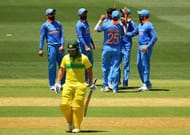
Both sides struggled greatly against the new ball, which is perhaps surprising given that the likes of Bumrah, Starc and Hazlewood were absent.
However, the players filling the holes these players left did an admirable job. Bhuvneshwar Kumar topped the wicket-taking charts, taking eight for the series at just 17.38 a piece. Jhye Richardson was similarly effective, taking six wickets at an average of 18.67.
Contrastingly, Rohit Sharma was the only one of the four openers to have any joy, as all the others finished the series with averages below 20.
The Australian openers, in particular, struggled. Their opening partnerships only resulted in 35 runs across the series. Aaron Finch's miserable form continued, as he averaged just 8.67 across the series, while Alex Carey's promotion to opener also proved unsuccessful, as he only averaged 15.67.
This brings into question why Australia didn't instead try opening with either Shaun Marsh or Usman Khawaja, with the former having opened for Australia several times before in ODIs.
India will also be disappointed that Shikhar Dhawan failed to make an impact in Rahul's absence, as he averaged just 18.33 throughout the series. With a career average of 44.95 and a strike-rate of 93.99, the fact Dhawan isn't a constant fixture in their ODI team only reaffirms their batting depth. However, it is still a chance missed for Dhawan.
#2 Indian spin-bowlers took 10 wickets compared to Australia's one
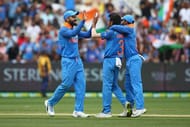
Chahal's 6/47 in the final ODI was probably the best performance of the series. It took him to second on the wicket-takers chart despite this having been the only ODI he played in the series. Up to this point, Australia had managed India's other spin bowlers fairly well, as they limited Kuldeep Yadav and Ravindra Jadeja to just two wickets each in the series.
However, the four wickets these two took between them were all top-order batsmen who were all on scores of 20 or more, and therefore should have been settled.
Australia's struggles against spin have greatly limited their ability to build through the middle overs of a match, and this proved to be the case once more. India, meanwhile, handled the various spin combinations Australia threw at them very well.
Glenn Maxwell's dismissal of Ambati Rayudu was Australia's only wicket across the 37 overs of spin they bowled throughout the series.
Nathan Lyon's recall to the ODI side was largely fruitless, as the Indian batsmen worked him for runs without too much risk. Adam Zampa's return was slightly more successful, as his figures of 0/34 in the 10 overs he bowled in the final ODI were at least economical.
The Australian selectors should have perhaps had more faith in Zampa. In 2016, his debut year, Zampa found himself one of the worlds leading wicket-takers for that year, with 30 wickets at 27.80.
However, he still surprisingly found himself dropped from the side before the year's end. Since then he has struggled for form, and his career average has climbed to 37.67. If Australia had handled Zampa a little differently, they might be approaching the World Cup with one of the worlds front line spin-bowlers, but instead, it is just another uncertain position in the Australian team.
#3 India only had two pace-bowlers take wickets
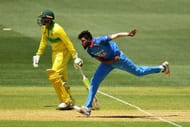
For the most part, this series showed that India has great depth in their side. Yet one area they may be concerned about is their pace-bowling depth.
While Kumar was brilliant, and Mohammed Shami was decent, India trialled three different pace-bowlers alongside Kumar and Shami with largely underwhelming results.
After a decent series against the West Indies earlier in the year, Khaleel Ahmed was selected for the first ODI, and was even given the new ball above Shami.
However, he didn't bowl his full quota of 10 overs, with figures of 0/55 off his eight overs. In fact, the two overs he didn't bowl were the ones Rayudu bowled instead, where he was later deemed to have a suspect action.
India, therefore, opted to hand Mohammed Siraj his debut for the second ODI, but his selection returned similar results, as he ended with 0/76 after bowling his 10 overs.
India then went for the all-round option of Vijay Shankar for the third ODI, and would have been much more encouraged by his performance. Shankar was only required to deliver six overs, but went about his work tidily, conceding just 23 runs.
India will, of course, have Bumrah back for the World Cup, but on the basis of this series, they will perhaps be a bit more concerned about who will step in if one of these three gets injured.
#4 MS Dhoni averaged 193 for the series
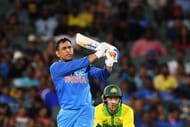
Dhoni's performance in the first ODI raised a lot of questions about his selection. His 51 in 96 balls seemed to greatly hamper India's chase, despite Dhoni being renowned for his ability to finish an innings.
Furthermore, this came on the back of a poor 2018 for Dhoni, where he averaged just 25.00 and had a meagre strike-rate of 71.43. 2018 also signalled the first time since his debut year in 2004 where Dhoni went a whole calendar year without scoring a fifty in ODIs.
However, by the end of the series, Dhoni had led his team to victory in two close chases, and had ensured he started 2019 with three consecutive fifties.
Dhoni's innings in the second and third ODIs were two masterclasses in chasing, with India winning both these games with Dhoni at the center and four balls to spare.
One notable statistic from Dhoni's innings in these two ODIs, is that only 36 of his 142 runs came from boundaries. This subsequently shows Dhoni's ability to keep the scorecard ticking over, and to adjust to a target fraction by fraction.
If Dhoni can maintain this type of form into the World Cup, then he will be a priceless quantity for India, who arguably already have the two best ODI batsmen in the world in Rohit Sharma and Virat Kohli.
#5 India now have three players who have over 50 wickets with bowling averages under 24
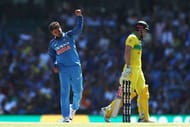
Of all the players in ODI history to have taken at least 50 wickets, Jasprit Bumrah and Kuldeep Yadav have the ninth and tenth best bowling averages respectively. This in itself is impressive, but after his 6/42 Yuzvendra Chahal now finds himself 29th on this list, with an average better than the likes of Waqar Younis, Curtly Ambrose and Imran Tahir.
With Yadav 24 years old, Bumrah 25 and Chahal 28, India can expect to have these three in and around the squad for some time yet. Even in three World Cups time, Chahal would only be 36, which for a spin-bowler isn't too old to still be playing at a high level.
The future of India's ODI bowling attack, therefore, looks very bright, with the only major problem being that it is difficult for them to fit Jadeja, Yadav and Chahal into the one side.
This no doubt provides a headache for the Indian selectors, but a headache caused by the need to leave out a bowler with an average among the best of all-time probably isn't the worst type to have.
Click here to get India Squad for T20 World Cup 2024. Follow Sportskeeda for the T20 World Cup Schedule, Points Table, and news
